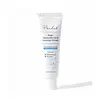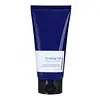What's inside
What's inside
 Key Ingredients
Key Ingredients

 Benefits
Benefits

 Concerns
Concerns

 Ingredients Side-by-side
Ingredients Side-by-side

Water
Skin ConditioningButylene Glycol
HumectantCaprylic/Capric Triglyceride
MaskingGlycerin
HumectantCetearyl Alcohol
EmollientCetearyl Olivate
Limnanthes Alba Seed Oil
Skin ConditioningMangifera Indica Seed Butter
Skin ConditioningSorbitan Olivate
EmulsifyingCynanchum Atratum Extract
Skin ConditioningSodium Hyaluronate
HumectantCamellia Japonica Leaf Extract
Skin ConditioningBeta-Glucan
Skin ConditioningSimmondsia Chinensis Seed Oil
EmollientBetaine
HumectantHydrolyzed Hyaluronic Acid
HumectantSodium Acetylated Hyaluronate
HumectantIsododecane
EmollientSodium Polyacryloyldimethyl Taurate
Emulsion StabilisingXanthan Gum
EmulsifyingTrideceth-10
CleansingEuphorbia Cerifera Wax
Boswellia Serrata Resin Extract
Smoothing1,2-Hexanediol
Skin ConditioningHydrogenated Polydecene
EmollientDimethicone/Vinyl Dimethicone Crosspolymer
Skin ConditioningDisodium EDTA
Ethylhexylglycerin
Skin ConditioningDimethicone
EmollientWater, Butylene Glycol, Caprylic/Capric Triglyceride, Glycerin, Cetearyl Alcohol, Cetearyl Olivate, Limnanthes Alba Seed Oil, Mangifera Indica Seed Butter, Sorbitan Olivate, Cynanchum Atratum Extract, Sodium Hyaluronate, Camellia Japonica Leaf Extract, Beta-Glucan, Simmondsia Chinensis Seed Oil, Betaine, Hydrolyzed Hyaluronic Acid, Sodium Acetylated Hyaluronate, Isododecane, Sodium Polyacryloyldimethyl Taurate, Xanthan Gum, Trideceth-10, Euphorbia Cerifera Wax, Boswellia Serrata Resin Extract, 1,2-Hexanediol, Hydrogenated Polydecene, Dimethicone/Vinyl Dimethicone Crosspolymer, Disodium EDTA, Ethylhexylglycerin, Dimethicone
Water
Skin ConditioningGlycerin
HumectantMethylpropanediol
SolventCaprylic/Capric Triglyceride
MaskingCetearyl Alcohol
EmollientMacadamia Ternifolia Seed Oil
EmollientHydrogenated Polydecene
EmollientButyrospermum Parkii Butter
Skin ConditioningGlyceryl Stearate
EmollientLonicera Japonica Flower Extract
Skin ConditioningArachidyl Alcohol
EmollientBehenyl Alcohol
EmollientArachidyl Glucoside
EmulsifyingPhenyl Trimethicone
Skin ConditioningCetearyl Glucoside
EmulsifyingBeeswax
Emulsion StabilisingSorbitan Stearate
EmulsifyingCellulose Gum
Emulsion StabilisingCeramide NP
Skin ConditioningYeast Beta-Glucan
Skin ConditioningCopper Tripeptide-1
Skin ConditioningButylene Glycol
HumectantHydrogenated Lecithin
EmulsifyingOctyldodecanol
EmollientCarbomer
Emulsion StabilisingHydroxyacetophenone
AntioxidantMyrtus Communis Extract
AstringentTropaeolum Majus Extract
AntimicrobialTromethamine
BufferingDisodium EDTA
Ethylhexylglycerin
Skin ConditioningWater, Glycerin, Methylpropanediol, Caprylic/Capric Triglyceride, Cetearyl Alcohol, Macadamia Ternifolia Seed Oil, Hydrogenated Polydecene, Butyrospermum Parkii Butter, Glyceryl Stearate, Lonicera Japonica Flower Extract, Arachidyl Alcohol, Behenyl Alcohol, Arachidyl Glucoside, Phenyl Trimethicone, Cetearyl Glucoside, Beeswax, Sorbitan Stearate, Cellulose Gum, Ceramide NP, Yeast Beta-Glucan, Copper Tripeptide-1, Butylene Glycol, Hydrogenated Lecithin, Octyldodecanol, Carbomer, Hydroxyacetophenone, Myrtus Communis Extract, Tropaeolum Majus Extract, Tromethamine, Disodium EDTA, Ethylhexylglycerin
 Reviews
Reviews

Ingredients Explained
These ingredients are found in both products.
Ingredients higher up in an ingredient list are typically present in a larger amount.
Butylene Glycol (or BG) is used within cosmetic products for a few different reasons:
Overall, Butylene Glycol is a safe and well-rounded ingredient that works well with other ingredients.
Though this ingredient works well with most skin types, some people with sensitive skin may experience a reaction such as allergic rashes, closed comedones, or itchiness.
Learn more about Butylene GlycolThis ingredient is an emollient, solvent, and texture enhancer. It is considered a skin-softener by helping the skin prevent moisture loss.
It helps thicken a product's formula and makes it easier to spread by dissolving clumping compounds.
Caprylic Triglyceride is made by combining glycerin with coconut oil, forming a clear liquid.
While there is an assumption Caprylic Triglyceride can clog pores due to it being derived from coconut oil, there is no research supporting this.
Learn more about Caprylic/Capric TriglycerideCetearyl alcohol is a mixture of two fatty alcohols: cetyl alcohol and stearyl alcohol. It is mainly used as an emulsifier. Emulsifiers help prevent the separation of oils and products. Due to its composition, it can also be used to thicken a product or help create foam.
Cetearyl alcohol is an emollient. Emollients help soothe and hydrate the skin by trapping moisture.
Studies show Cetearyl alcohol is non-toxic and non-irritating. The FDA allows products labeled "alcohol-free" to have fatty alcohols.
This ingredient is usually derived from plant oils such as palm, vegetable, or coconut oils. There is debate on whether this ingredient will cause acne.
Due to the fatty acid base, this ingredient may not be Malassezia folliculitis safe.
Learn more about Cetearyl AlcoholDisodium EDTA plays a role in making products more stable by aiding other preservatives.
It is a chelating agent, meaning it neutralizes metal ions that may be found in a product.
Disodium EDTA is a salt of edetic acid and is found to be safe in cosmetic ingredients.
Learn more about Disodium EDTAEthylhexylglycerin (we can't pronounce this either) is commonly used as a preservative and skin softener. It is derived from glyceryl.
You might see Ethylhexylglycerin often paired with other preservatives such as phenoxyethanol. Ethylhexylglycerin has been found to increase the effectiveness of these other preservatives.
Glycerin is already naturally found in your skin. It helps moisturize and protect your skin.
A study from 2016 found glycerin to be more effective as a humectant than AHAs and hyaluronic acid.
As a humectant, it helps the skin stay hydrated by pulling moisture to your skin. The low molecular weight of glycerin allows it to pull moisture into the deeper layers of your skin.
Hydrated skin improves your skin barrier; Your skin barrier helps protect against irritants and bacteria.
Glycerin has also been found to have antimicrobial and antiviral properties. Due to these properties, glycerin is often used in wound and burn treatments.
In cosmetics, glycerin is usually derived from plants such as soybean or palm. However, it can also be sourced from animals, such as tallow or animal fat.
This ingredient is organic, colorless, odorless, and non-toxic.
Glycerin is the name for this ingredient in American English. British English uses Glycerol/Glycerine.
Learn more about GlycerinHydrogenated Polydecene is an emollient. It creates a non-occlusive film on the skin that offers extra protection for your skin barrier.
The texture of Hydrogenated Polydecene ranges from light and silky to rich.
Hydrogenated Polydecene is the end compound of controlled hydrogenation of Polydecene.
Learn more about Hydrogenated PolydeceneWater. It's the most common cosmetic ingredient of all. You'll usually see it at the top of ingredient lists, meaning that it makes up the largest part of the product.
So why is it so popular? Water most often acts as a solvent - this means that it helps dissolve other ingredients into the formulation.
You'll also recognize water as that liquid we all need to stay alive. If you see this, drink a glass of water. Stay hydrated!
Learn more about Water